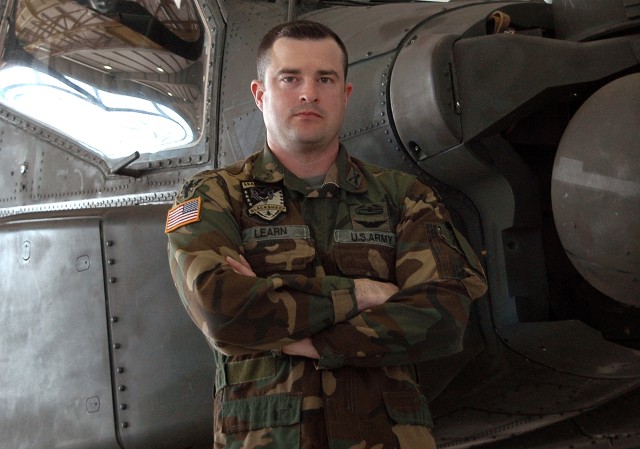
ANSBACH, Germany (Army News Service, April 12, 2007) - On a routine air-assault mission in Afghanistan, six aircraft from what is now V Corps' 12th Combat Aviation Brigade and members of the Canadian Special Forces were ordered to perform a raid on a high-value target. As the first aircraft, a CH-47 Chinook, started downward to insert the Canadian soldiers, a rocket-propelled grenade struck its side, engulfing the big twin-rotor helicopter in flames.
That's when Chief Warrant Officer 2 Philip Learn, an AH-64D Apache "Longbow" pilot from the 12th's 3rd Battalion, 159th Aviation Regiment, took action.
As the burning helicopter attempted to land, Chief Learn said, 10 enemies with small arms and RPGs advanced on it.
The pilot quickly redirected a second Chinook, preventing it from landing in the hostile landing zone.
He then turned his attention to the burning aircraft on the ground. Its crew and 34 passengers were pinned down by intense small-arms fire. Within seconds Chief Learn put his Apache in a covering position under direct enemy fire.
Rocket-propelled grenades crossed under his aircraft, but Chief Learn said he kept his aircraft low and continued to fight until the enemy advance was halted.
Apache pilots are trained to stand off while firing. They learn to provide cover fire without crossing into enemy range. The mountains of Afghanistan make that tactic difficult.
"It's hard to pick out individuals in the mountains," Chief Learn said. "When I was firing, I was about 70 to 100 feet over the downed aircraft, trying to provide cover. That was the only way to do it without causing a fratricide."
Chief Learn said he was in the air for about eight hours that day, engaging enemy forces on the ground, making several passes while dodging enemy fire, and making trips back to a Forward Arming and Refueling Point just long enough to refuel.
At the end of the day, the incident ended without a single friendly casualty because of Chief Learn's actions.
"That was one of several long days in Afghanistan," the pilot said.
In total, Chief Learn said, he took part in eight large fights during his 12 months in Afghanistan. He became the most decorated warrant officer in the 12th's Task Force Storm, earning the Distinguished Flying Cross, two Air Medals with Valor and three Air Medals.
Chief Learn's distinguished service recently earned him another unique tribute, when he was named Aviator of the Year by the Army Aviation Association of America.
Lt. Col. Don Fallin, Learn's battalion commander, said the pilot's actions in combat are just part of the reason he was selected for that honor.
"He's had a pattern of doing well," said Lt. Col. Fallin. "A lot of times you'll see senior warrants get these awards. He shows a lot of maturity and judgment for a guy who's only been flying a few years."
After serving in various positions as an Army NCO and in the civilian workforce, including combat engineer, air traffic controller and police officer, Chief Learn said he decided in 2002 to apply to become an aviation warrant officer. He barely made the cutoff age of 29 years old. A year later he graduated the Apache course with honors.
"My background has made a big difference in my success," he said. "Being able to make hard decisions in violent situations gave me a leg up. Being a prior noncommissioned officer helped, because I know how the Army works."
Chief Learn has moved up the Army aviation ladder quickly. A typical Apache pilot becomes a pilot-in-command with somewhere between 500 to 700 hours of flight time. He passed his evaluation with only 348 hours.
He now serves as an Apache pilot instructor. While he realizes that he's still very junior to be an instructor pilot, he also knows that he has the experience to guide and mentor newer pilots.
"We were the first Longbow unit to go to Afghanistan," he said. "They're teaching what we learned there at the schoolhouse today. New pilots learn a lot more running fires than when I came through ... they only learn a few hovering engagements."
Chief Learn said he will be with the 12th CAB at least through 2010. While much of the CAB is ramping up for deployment to Iraq later this year, Learn and the 3rd Bn., 159th Avn. Regt., will remain in Germany preparing for the next deployment.
His said his advice for the pilots preparing to deploy is the same as his advice to his student pilots: Stay focused - it's an endurance race, not a sprint.
"Try not to take unnecessary risks," he said. "Bring the ground forces home safe. That's our job."
(Sgt. 1st Class Chris Seaton writes for the 12th Combat Aviation Brigade Public Affairs Office.)

Social Sharing